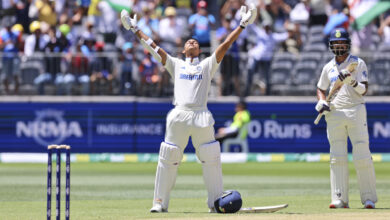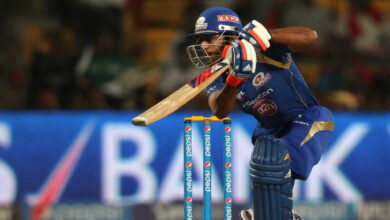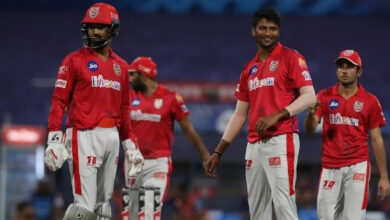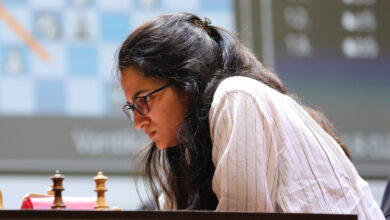Nooshin Al Khadeer’s journey from aggressive competitor to U-19 Women’s World Cup-winning coach

Nooshin Al Khadeer hasn’t even had the chance to put her feet up and enjoy a brief break. Being the head coach of the India Under-19 women’s team, the last few months have been busy in every sense. Be it a preparatory camp at the NCA, a bilateral series in Vizag, or a preparatory camp in South Africa, Nooshin was at the forefront of everything. The reward: India getting their hands on the inaugural Under-19 World Cup trophy on January 29, defeating England in the final.
While Nooshin was looking for a breather, she is getting to experience what it feels to be part of a team that became the first women’s team to bring an ICC title home – a completion of a well-deserved redemption arc. Nooshin was, in fact, the final Indian batter to have gotten out in the 2005 Women’s ODI World Cup final against Australia, giving the Aussies the fifth of their seven titles.
After landing in Mumbai, she left for Ahmedabad, where the BCCI felicitated the team, before taking the next flight to Ranchi to be part of the Railways team at the ongoing Senior Women’s One-Day tournament. “After winning the title, I told the team it is just the start. And even some of the players feel the same way. So it is important to get down to business straightaway,” Nooshin tells the Indian Express.
Thank you sir @JayShah @BCCI and @sachin_rt for the felicitation and honour . #u19WomensT20WorldCup #Champions @BCCIWomen #honored #blessed pic.twitter.com/zQ2yP4bd6U
— Nooshin AL Khadeer (@NooshinKhadeer) February 4, 2023
Those who know Nooshin up close attribute this dedication and hardwork to her success. Be it Vinod Sharma, who was the head coach of the Railways team she represented for long, her India teammate Punam Raut, or her long-time friend and teammate Mithali Raj, all have a common thing to say: “She was destined to be a coach.”
Lessons in patience
There was, however, one thing Nooshin still had to take care of before charting her path as a coach.
“She was an aggressive player who always wanted things to work out on the field. But you can’t have the same trait as a coach,” Mithali says of her friend. “When she decided to get into coaching, it was something we had a conversation about. When you are a coach, you are not only coaching the seniors, but you also have to coach youngsters, and you need to develop patience. She worked hard on that. That is her biggest transformation,” she adds.
A key part of developing that patience started when Nooshin moved to Hyderabad, where she began her coaching stint with the Under-16 side for two years before moving to the Chhattisgarh senior side.
“I would say I never rushed into coaching saying ‘look I’m an Indian player and I’ve contributed for so long, I have to take up a senior side.’ I wasn’t eligible for it. I wanted to get through the levels — Level A, and B,” Nooshin said.
“Playing and coaching are two different roles. This is a totally different profession, and I’m glad that I understood that early in my life. I took up Chhattisgarh because I wanted to test myself, especially my patience. Coaching needs calmness and patience because I really had to go down to their level, explain things, and build a team,” she added.
Nooshin was, in fact, the final Indian batter to have gotten out in the 2005 Women’s ODI World Cup final against Australia, giving the Aussies the fifth of their seven titles. (Special Arrangement)
As Chhattisgarh did well making it to the knockouts, her employer Railways would come calling. For a team that is known to win silverware, they had just lost two big titles, and as they pressed the reset button, they came calling for Nooshin. “I had no choice but to take that because I still had a contract running with Chhattisgarh. But since it is the institution that I work for, I took it up as a challenge.”
It is at Railways that Mithali would first see a different Nooshin. The aggressive player, and one who didn’t hesitate to speak her mind, was long gone. “When she came to Railways, I could see she was not Nooshin, the player I knew. Standing in front of us was Nooshin, the coach. And that is when I started to trust her and we started having a lot of conversations about my batting, the team and a lot of other stuff,” Mithali says.
Understanding people
The smooth transition is also a reflection of how Nooshin was quick to adapt. According to her Railways coach Sharma, she has always had leadership qualities, and was especially good at communication. In a simple sense, she was a very vocal player, who wasn’t hesitant to share her views even when some of her senior players chose to stay mum.
“I’m a chatterbox, and I talk to everyone and anybody. To understand people, you need to know them, and the only way I can know someone is if I talk to them. There are 15 different players in the team and each one is different. So reading them is not easy.
“I talk to groundsmen, guys who carry water to the field, because it helps me improve my communication. I get to understand a lot of things talking to them. For someone to open up, you should make them comfortable and I think I have that natural capability to communicate well,” Nooshin says.
For a player who hung up her boots on March 16, 2012, she hardly had a break. While most players would have preferred to stay away from waking up early and hitting the ground, Nooshin was back on the ground in a fortnight. “On April 1, I was at a coaching camp in Hyderabad,” Nooshin says.
Mithali feels there was a reason for it as well. “I wasn’t surprised that she took up coaching. The way her career ended, she felt there was unfinished business. She wanted to give back to the game. She thought she could do something through coaching. And she worked very hard for it. Whenever I called her, she would be on the ground,” the former India skipper says.
“Look I could have been a selector or completed five years and be eligible to become a match referee. But that isn’t me. I wanted to give something back to the game, even 20 percent of what I learned. Why was never a question, but I never thought I would come this far,” Nooshin says.







